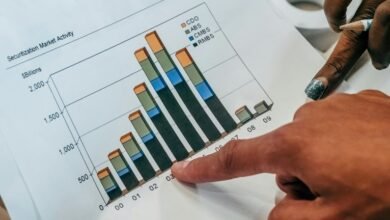50 Smart Investment Strategies for 2025

As the investment landscape evolves rapidly toward 2025, understanding strategic approaches becomes essential for resilient growth. Integrating ESG principles, harnessing technological innovations, and diversifying across asset classes are no longer optional but necessary for maintaining competitive advantage. With geopolitical shifts and regulatory updates constantly reshaping markets, investors must adopt a nuanced, proactive stance. This collection of 50 strategies offers a comprehensive roadmap—yet, the most effective tactics depend on careful analysis and timely adaptation.
Embrace Sustainable and ESG Investing
Has sustainable and ESG investing become a fundamental component of modern portfolios? Indeed, it aligns financial growth with social impact, emphasizing renewable energy and ethical practices.
This approach offers investors freedom through resilient, future-proof assets, fostering responsible growth while maintaining autonomy. Integrating ESG factors ensures both economic returns and meaningful contributions to societal progress.
Leverage Artificial Intelligence in Portfolio Management
Artificial intelligence enhances portfolio management through sophisticated asset allocation algorithms that adapt to market dynamics in real time.
Predictive analytics enable managers to forecast trends with greater accuracy, optimizing decision-making processes.
Integrating these AI-driven tools offers a competitive advantage by increasing efficiency and reducing human bias in investment strategies.
AI-Driven Asset Allocation
AI-driven asset allocation employs advanced algorithms and machine learning models to optimize portfolio diversification and risk management dynamically. Integrating quantum computing accelerates decision-making precision, while virtual real estate investments benefit from AI insights.
This approach empowers investors seeking freedom, enabling adaptive strategies that capitalize on emerging digital assets and complex market variables with unmatched efficiency and foresight.
Predictive Analytics Optimization
Predictive analytics optimization represents a sophisticated evolution in portfolio management, harnessing advanced artificial intelligence techniques to forecast market trends and asset performance with heightened accuracy.
By leveraging data-driven forecasting, investors gain strategic insights that enhance decision-making, offering greater autonomy.
This approach empowers portfolios with precision tools, enabling informed, flexible investments aligned with individual risk tolerance and market dynamics.
Diversify With International Markets
Investors can enhance portfolio resilience by analyzing global market trends, which often exhibit different growth cycles and risk profiles compared to domestic markets.
Currency diversification further mitigates risk by reducing exposure to localized economic fluctuations.
Incorporating international assets strategically positions portfolios to capitalize on emerging opportunities and stabilize returns amid shifting economic landscapes.
Global Market Trends
In 2025, expanding investment portfolios to include international markets remains a strategic imperative for achieving diversification and mitigating regional risks.
Evolving global trade policies and cryptocurrency regulations create both opportunities and hurdles, demanding vigilant analysis.
Investors seeking freedom must leverage these trends, recognizing that adaptive strategies in global markets offer resilience amid shifting geopolitical and economic landscapes.
Currency Diversification
Currency diversification with international markets enhances portfolio resilience by reducing dependence on any single economy and mitigating localized currency risk.
Utilizing digital wallets and seamless currency exchange enables investors to access global assets efficiently, fostering financial independence.
This strategic approach empowers freedom-seekers to navigate fluctuations confidently, ensuring diversified exposure and optimized returns across multiple currencies and markets.
Incorporate Cryptocurrencies Into Your Strategy
Incorporating cryptocurrencies into a diversified investment portfolio requires meticulous analysis of market dynamics, technological developments, and regulatory environments.
Understanding cryptocurrency regulation and prioritizing digital asset security are essential. This approach empowers investors seeking financial freedom, ensuring that strategic allocation balances risk and reward while safeguarding assets against regulatory shifts and security vulnerabilities.
Focus on Cybersecurity-Resilient Assets
As digital assets become increasingly integrated into investment portfolios, prioritizing cybersecurity-resilient assets has gained prominence.
Investing in cybersecurity assets enhances digital resilience, safeguarding portfolios from cyber threats and ensuring operational continuity.
This strategic focus empowers investors to maintain control and freedom, emphasizing assets designed to withstand breaches and foster long-term stability in an ever-evolving digital landscape.
Invest in Renewable Energy Projects
Investing in renewable energy projects offers a strategic opportunity to capitalize on the global transition toward sustainable power sources. By funding solar panels and wind turbines, investors can harness long-term growth potential while supporting energy independence.
This approach aligns with desires for freedom, offering resilience against market volatility and fostering a sustainable, autonomous energy future.
Utilize Robo-Advisors for Automated Investing
Robo-advisors offer personalized portfolio management by leveraging algorithms to tailor investments to individual risk profiles and financial goals.
They also provide low-cost access to diversified asset classes, reducing barriers for investors with limited capital.
As automation enhances efficiency and cost-effectiveness, integrating robo-advisors can optimize investment strategies for the evolving landscape of 2025.
Personalized Portfolio Management
How can investors optimize portfolio management in an increasingly digital financial landscape? Automated robo-advisors enable tailored investment strategies that adapt to individual risk profiles, ensuring optimal personal allocation.
This precision fosters financial independence by empowering investors to maintain control while benefiting from sophisticated algorithms that enhance diversification and responsiveness, aligning investments with personal goals effortlessly.
Low-Cost Investment Access
Access to affordable, automated investment platforms has significantly lowered barriers to entry for individual investors, enabling broad participation in diversified markets without extensive expertise or large upfront costs.
Robo-advisors facilitate strategic allocations into precious metals and art collectibles, offering freedom from traditional restrictions. This democratization empowers investors to diversify efficiently, enhancing control over wealth growth and safeguarding assets against market volatility.
Prioritize High-Growth Tech Startups
Prioritizing high-growth tech startups remains a strategic approach for investors seeking substantial returns in 2025. Focusing on ventures with blockchain integration and participation in startup incubators enhances diversification and scalability.
This targeted approach unlocks innovative opportunities, empowering investors to harness disruptive technologies and retain financial independence through strategic positions in emerging industry leaders.
Explore Impact Investing Opportunities
Exploring impact investing opportunities offers a strategic avenue for investors seeking both financial returns and positive societal change in 2025.
By emphasizing impact measurement and community engagement, investors can gauge tangible outcomes and foster local empowerment.
This data-driven approach ensures investments align with personal values while maximizing societal benefits, supporting informed, freedom-oriented decision-making.
Use Thematic Investing to Capitalize on Trends
Thematic investing has emerged as a compelling strategy for investors aiming to capitalize on emerging trends and structural shifts within various sectors. By leveraging sector rotation and thematic ETFs, investors can target high-growth areas aligned with long-term trends.
This approach enables strategic flexibility and diversification. It empowers individuals seeking freedom to optimize portfolios based on evolving economic and technological landscapes.
Apply Quantitative Analysis for Better Decision-Making
Applying quantitative analysis enhances investment decision-making by providing objective, data-driven insights that minimize emotional bias and subjective judgment.
Through advanced quantitative modeling, investors gain precise, scalable metrics that support strategic choices.
These data-driven insights empower individuals seeking financial independence to optimize portfolios with rigorous, analytical rigor, fostering informed, autonomous investment solutions.
Incorporate Real Assets Like Real Estate and Commodities
Integrating tangible assets such as real estate and commodities can enhance portfolio stability by providing intrinsic value and inflation protection.
Diversification through commodities offers exposure to different market drivers, reducing overall risk.
Current market trends indicate growth opportunities in real estate sectors aligned with demographic shifts and urban development.
Benefits of Tangible Assets
What advantages do tangible assets such as real estate and commodities offer within a diversified investment portfolio? These physical commodities provide intrinsic value, acting as a hedge against inflation and economic volatility.
Tangible assets enhance portfolio resilience, offering tangible security and independence. They align with investors seeking freedom from market uncertainties through strategic allocation of real assets.
Diversification With Commodities
How can incorporating commodities and real estate into an investment portfolio enhance diversification and risk management?
Commodities offer high liquidity and act as an inflation hedge.
While commodity storage strategies mitigate volatility.
These real assets provide stability and independence, empowering investors seeking financial freedom through resilient, tangible investments that diversify beyond traditional equities and bonds.
Market Trends in Real Estate
Examining current market trends reveals a notable shift toward increased interest in real estate and commodities as vital components of resilient investment portfolios. Investors are increasingly drawn to luxury condominiums and historic properties, recognizing their potential for appreciation and stability.
These assets offer freedom from volatility, emphasizing long-term value and diversification in a dynamic economic landscape.
Adopt a Long-Term Growth Perspective
Adopting a long-term growth perspective is a fundamental principle that underpins successful investment strategies in 2025.
By leveraging compound interest and consistent dollar cost averaging, investors can optimize wealth accumulation.
This approach fosters financial independence, minimizes market timing risks, and ensures steady growth—empowering individuals to achieve freedom through disciplined, future-focused investments.
Hedge Against Inflation With Alternative Assets
Precious metals, such as gold and silver, are historically recognized for maintaining value during inflationary periods, offering a stable store of wealth.
Similarly, real assets like real estate and commodities demonstrate resilience by providing tangible protection against currency devaluation.
Incorporating these alternative assets into investment portfolios can serve as an effective hedge, preserving purchasing power amid economic fluctuations.
Precious Metals’ Stability
Among various investment options, precious metals such as gold and silver have historically demonstrated resilience during periods of inflation. They serve as a reliable hedge against declining fiat currency values.
Their intrinsic value promotes price stability, making precious metals a strategic choice for those seeking financial independence and long-term security, especially amid economic uncertainties and currency devaluation.
Real Assets’ Resilience
Real assets, including infrastructure, farmland, and energy resources, have demonstrated notable resilience during inflationary periods by maintaining intrinsic value and generating tangible income streams.
Their historical resilience underscores their effectiveness as inflation hedges, empowering investors seeking financial independence.
These alternative assets offer stability and growth potential, making them essential components of a diversified, freedom-oriented portfolio in uncertain economic climates.
Invest in Biotech and Healthcare Innovation
Why should investors consider biotech and healthcare innovation as a strategic component of their portfolios in 2025? Advances in gene editing and biologic therapies promise transformative breakthroughs, offering substantial growth potential.
These innovations foster independence through personalized treatments, disrupting traditional paradigms. They align with a future-driven approach—empowering investors to capitalize on revolutionary healthcare developments while maintaining control over their financial freedom.
Take Advantage of Fractional Investing Platforms
How can investors maximize diversification and access high-value assets with limited capital? Fractional investing platforms enable micro investment in premium assets, breaking traditional barriers.
Diversify Using Exchange-Traded Funds (ETFs)
What makes exchange-traded funds (ETFs) a compelling tool for diversification in 2025 is their ability to combine broad market exposure with cost efficiency. They enable investors to hedge risks like cryptocurrency mining volatility and blockchain security concerns, fostering resilience.
This strategic flexibility empowers individuals seeking financial freedom through diversified, liquid assets aligned with evolving technological landscapes.
Follow Regulatory Changes for Strategic Opportunities
Monitoring regulatory developments is increasingly vital for investors aiming to capitalize on emerging opportunities in 2025. Staying abreast of policy updates ensures strategic agility and regulatory compliance, unlocking potential market advantages.
Analyzing these shifts allows investors to anticipate changes, adapt proactively, and leverage opportunities that align with evolving legal frameworks, fostering informed, freedom-driven investment decisions.
Maximize Tax-Advantaged Accounts
Maximizing the benefits of tax-advantaged accounts is a fundamental component of a strategic investment approach in 2025.
By leveraging tax-efficient investing within retirement planning, investors can optimize growth potential and preserve wealth.
Prioritizing these accounts ensures greater financial independence, enabling long-term freedom from tax burdens and enhancing overall portfolio resilience.
Focus on Emerging Markets With Growth Potential
Emerging markets present compelling opportunities due to their rapid economic expansion and demographic shifts.
High-growth regions are increasingly attracting investment, driven by urbanization and technological adoption.
Focusing on these areas can enhance portfolio diversification and capitalize on the long-term potential of rising economies.
Rising Market Opportunities
As global economic dynamics shift, emerging markets with robust growth potential present compelling opportunities for strategic investment.
Identifying emerging niches and niche sectors enables investors to capitalize on innovative industries before mainstream recognition. These opportunities offer autonomy and diversification, empowering investors to shape their financial futures through targeted engagement in high-potential markets poised for exponential expansion.
High-Growth Regions
Identifying high-growth regions within emerging markets requires a strategic assessment of macroeconomic indicators, political stability, and infrastructural development.
Regional analysis reveals promising opportunities where economic momentum aligns with investor freedom. These emerging markets offer transformative potential, making them compelling focus areas for those seeking to maximize growth and influence in the evolving global landscape.
Invest in Digital Infrastructure and 5G Technologies
Why is investing in digital infrastructure and 5G technologies considered a critical component of future-proofing portfolios? Smart infrastructure and 5G deployment enable increased connectivity, efficiency, and innovation.
These advancements empower individuals to harness technological freedom. Strategic investments in these sectors accelerate digital transformation, ensuring resilience and growth opportunities in an increasingly interconnected world.
Use Data Analytics to Track Market Trends
Leveraging data analytics to monitor market trends enhances the precision and responsiveness of investment strategies in an increasingly complex financial landscape.
Data visualization and predictive modeling enable investors to identify patterns, forecast shifts, and make informed decisions.
This analytical approach empowers individuals seeking financial freedom to stay ahead of market fluctuations with clarity and confidence.
Incorporate Socially Responsible Investment Funds
Incorporating socially responsible investment funds (SRI) has become an essential component of modern portfolio management. This shift reflects a growing emphasis on ethical considerations alongside financial returns.
Explore Peer-to-Peer Lending Platforms
Peer-to-peer lending platforms offer a compelling avenue for portfolio diversification, enabling investors to access alternative asset classes with potentially higher yields.
However, such investments carry distinct risks, including borrower default and platform stability, underscoring the importance of rigorous due diligence.
A strategic approach to evaluating these platforms can mitigate exposure and enhance long-term investment resilience.
Diversification Benefits of P2P
Although often overlooked in traditional portfolios, P2P lending platforms offer a valuable diversification opportunity by providing access to a different asset class characterized by distinct risk-return profiles.
Peer lending, as an alternative model, reduces correlation with equities and bonds, enhancing portfolio resilience.
This strategic inclusion supports investors seeking freedom through varied, innovative investment avenues.
Risks and Due Diligence
While the diversification benefits of P2P lending platforms are notable, understanding the associated risks and implementing thorough due diligence are vital steps for investors.
Prioritizing regulatory compliance and fraud prevention measures ensures access to transparent, secure opportunities.
Diligent assessment minimizes exposure to borrower defaults and platform vulnerabilities, empowering investors to make informed, freedom-oriented decisions in an evolving financial landscape.
Keep Abreast of Geopolitical Developments
How can investors effectively navigate the complexities of global power shifts and regional conflicts in 2025?
By monitoring geopolitical developments, understanding trade sanctions, and evaluating diplomatic negotiations, investors can identify emerging risks and opportunities.
Staying informed enables strategic positioning, minimizes exposure to instability, and preserves the freedom to adapt quickly, ensuring resilient portfolios amid shifting international landscapes.
Invest in Fintech Companies Disrupting Traditional Banking
The expansion of digital lending platforms exemplifies how fintech firms are challenging conventional banking models by offering faster, more accessible credit solutions.
Blockchain technology further enhances these companies’ value propositions through increased transparency, security, and efficiency.
Investing in such disruptive entities aligns with the ongoing shift toward decentralized financial services that are reshaping industry standards.
Rise of Digital Lending
Digital lending has emerged as a transformative force within the financial sector, driven by innovative fintech startups that leverage advancements in technology to challenge traditional banking models.
Peer-to-peer digital lending platforms offer unparalleled access to capital, empowering investors seeking financial independence.
This disruptive trend signals a shift toward decentralized, flexible lending solutions that prioritize user control and democratize financial opportunities.
Blockchain Integration Benefits
Blockchain integration offers significant advantages for fintech companies seeking to disrupt traditional banking models by enhancing security, transparency, and operational efficiency. Improved token security safeguards assets, while transaction transparency fosters trust and accountability.
These benefits enable innovative financial solutions that empower users with greater control and freedom, making blockchain-enabled fintech firms compelling investment opportunities in the evolving financial landscape.
Use Algorithmic Trading for Precise Entry and Exit Points
Algorithmic trading employs sophisticated algorithms to analyze market data and execute trades with unparalleled speed and accuracy.
Utilizing advanced quantitative models and machine learning, it identifies optimal entry and exit points precisely.
This approach empowers investors seeking freedom by reducing emotional biases, enhancing decision-making, and maximizing profitability through data-driven strategies tailored for a dynamic 2025 market landscape.
Allocate Capital to Space and Satellite Technologies
Allocating capital to space and satellite technologies presents a strategic opportunity for investors seeking high-growth potential in 2025. Advancements in satellite constellations enable global connectivity.
The burgeoning space tourism sector offers diversification and innovation. Strategic investment in these areas supports technological freedom and positions investors to capitalize on expanding markets driven by demand for enhanced communication and recreational experiences.
Prioritize Investments With Strong Dividend Yields
Prioritizing investments with strong dividend yields remains a crucial strategy for investors aiming to generate steady income streams and enhance portfolio resilience in 2025.
Emphasizing dividend growth ensures income stability, empowering investors seeking financial freedom.
Consistent dividends reflect robust fundamentals, making these assets attractive for those focused on long-term stability and sustainable income generation amidst market volatility.
Explore Venture Capital and Private Equity Opportunities
Are venture capital and private equity investments viable strategies for diversifying portfolios in 2025? These avenues offer access to early stage startups and niche venture funds, providing high-growth potential and independence from traditional markets.
While riskier, strategic engagement in these sectors enables investors to capitalize on innovative ventures and retain control over their financial freedom.
Use Dollar-Cost Averaging to Mitigate Market Volatility
How can investors effectively reduce the impact of market volatility on their portfolios?
Dollar-cost averaging streamlines retirement planning and enhances cash flow management by spreading investments over time, minimizing timing risks.
This disciplined approach fosters financial independence, ensuring steady growth despite market fluctuations—empowering investors to sustain their freedom through strategic, risk-mitigating investment practices.
Invest in Water Resources and Management Technologies
Investing in water resources and management technologies offers a strategic avenue for addressing global water scarcity and infrastructure challenges. Emerging innovations, such as smart sensors and automated distribution systems, enhance efficiency and resource conservation.
Prioritizing sustainable management practices ensures long-term viability and resilience of water systems, making this sector a compelling component of future-oriented investment portfolios.
Innovative Water Technologies
What makes water management technologies a compelling investment opportunity in 2025 is their potential to address escalating water scarcity through innovative solutions like advanced desalination techniques and water conservation innovations.
These technologies offer scalable, efficient methods to optimize resource use, empowering stakeholders seeking freedom from water dependency while ensuring sustainable infrastructure development and resilient water supply systems.
Sustainable Management Practices
As technological innovations continue to evolve in water management, the focus increasingly shifts toward sustainable practices that ensure long-term resource viability.
Investing in eco-friendly packaging and green supply chains optimizes water use, reduces environmental impact, and supports resilient ecosystems.
These strategies empower stakeholders to pursue sustainable growth, fostering independence and environmental stewardship in water resource management.
Stay Updated on Cryptocurrency Regulations
Staying informed about evolving cryptocurrency regulations is essential for investors aiming to mitigate legal risks and capitalize on emerging opportunities.
Understanding shifts in cryptocurrency taxation and digital asset licensing ensures compliance and strategic advantage.
Vigilant tracking empowers investors to navigate complex legal frameworks, safeguarding their freedom to innovate while optimizing returns in the dynamic digital asset landscape.
Capitalize on Automation and Robotics Advancements
Advancements in automation and robotics are transforming industries by enhancing operational efficiency, reducing labor costs, and increasing precision.
Automated customer service and robotic process automation streamline workflows, offering investors opportunities in tech-driven sectors.
Embracing these innovations enables strategic freedom, optimizing returns while minimizing dependencies on traditional labor, and positioning portfolios for sustained growth in an increasingly automated economy.
Diversify Across Different Asset Classes
Building on the momentum generated by automation and robotics, investors are increasingly recognizing the importance of diversification across multiple asset classes to mitigate risks and enhance returns.
Incorporating cryptocurrency mining and art investments offers tailored opportunities for freedom-seeking individuals, balancing traditional assets with innovative alternatives.
This strategic approach maximizes resilience amid market volatility and broadens wealth preservation avenues.
Leverage Social Media and Market Sentiment Analysis
Utilizing social media platforms and market sentiment analysis has become an essential component of modern investment strategies, offering real-time insights into investor behavior and prevailing trends.
Influencer marketing and viral campaigns can signal emerging opportunities, enabling investors to anticipate market shifts.
This approach empowers individuals seeking financial freedom to harness collective sentiment and capitalize on timely trends effectively.
Focus on Companies With Strong ESG Ratings
Research indicates that companies with strong ESG ratings tend to outperform their peers over the long term, driven by sustainable practices and risk mitigation.
Identifying leading ESG firms requires a rigorous assessment of governance, environmental, and social metrics, which can signal resilience and growth potential.
Prioritizing such companies aligns investment portfolios with emerging regulatory trends and shifting consumer preferences, potentially enhancing returns.
ESG Impact on Returns
Companies with high ESG (Environmental, Social, and Governance) ratings have demonstrated a measurable positive correlation with financial performance. This challenges traditional notions that sustainability considerations compromise profitability.
Strong corporate governance and social responsibility initiatives foster resilience and long-term value. This illustrates that prioritizing ESG factors enhances returns without sacrificing strategic independence.
Ultimately, this trend empowers investors seeking sustainable growth and financial freedom.
Identifying Leading ESG Firms
Identifying leading ESG firms requires a systematic evaluation of companies that consistently demonstrate high standards across environmental, social, and governance criteria.
Emphasizing corporate transparency and ethical leadership ensures authentic commitment to sustainability.
These firms offer investors a pathway to align values with performance, fostering independence and resilience through principled practices that set industry benchmarks for responsible governance.
Explore Alternative Investment Funds (AIFs)
Alternative Investment Funds (AIFs) have gained increasing prominence as sophisticated vehicles that enable investors to diversify beyond traditional asset classes, such as equities and bonds.
Effective fund managers navigate liquidity risk, offering strategic flexibility.
Embracing AIFs empowers investors seeking freedom through tailored, high-caliber opportunities, though careful risk assessment remains essential for optimal portfolio resilience.
Invest in Cybersecurity Firms
The escalating frequency and sophistication of cyber threats have significantly increased the demand for advanced security solutions, positioning cybersecurity firms as vital players in digital infrastructure. Continuous innovation within the sector is fueling growth, as companies develop more effective defenses and proactive threat detection technologies.
Investing in these firms offers a strategic opportunity to capitalize on a resilient industry driven by persistent security challenges.
Rising Threats Spur Demand
As global digital infrastructure becomes increasingly complex and interconnected, the frequency and sophistication of cyber threats have surged correspondingly.
Rising cybersecurity threats threaten data privacy, prompting organizations to invest heavily in cybersecurity firms.
This demand reflects an essential shift towards safeguarding digital assets, offering strategic opportunities for investors seeking to empower freedom through resilient, innovative cybersecurity solutions.
Innovation Drives Growth
Innovative advancements within cybersecurity are acting as catalysts for sustained industry growth, driven by the relentless evolution of digital threats and the increasing sophistication of cyberattacks.
Quantum computing and space exploration innovations are expanding cybersecurity frontiers, enabling firms to develop resilient strategies that safeguard technological sovereignty, ensuring freedom from cyber vulnerabilities in an interconnected, digital universe.
Incorporate Behavioral Finance Principles
Incorporating behavioral finance principles into investment strategies recognizes that psychological biases and emotional responses significantly influence decision-making processes.
Understanding behavioral biases and investor psychology enables investors to identify irrational tendencies, fostering more objective choices.
Use Stop-Loss and Take-Profit Orders to Manage Risks
How can investors effectively limit potential losses and secure profits in volatile markets? Implementing stop-loss orders and take-profit orders provides disciplined risk management, allowing traders to exit positions automatically at predetermined levels.
This strategic use of stop-loss orders and take-profit orders empowers investors with autonomy, minimizing emotional decision-making while maximizing control over risk and gains in uncertain environments.
Track Macroeconomic Indicators for Timing Decisions
Monitoring macroeconomic indicators such as GDP growth rates, employment trends, and inflation patterns provides critical insights into economic cycles and market timing.
Precise analysis of these data points allows investors to identify opportunities and risks with greater accuracy.
Integrating these indicators into decision-making frameworks enhances the ability to optimize portfolio performance in dynamic economic environments.
Monitor GDP Growth Rates
Tracking GDP growth rates provides essential insights into the overall health and trajectory of an economy, serving as a crucial macroeconomic indicator for timing investment decisions.
Effective GDP monitoring enables investors to identify economic expansion or contraction phases, leveraging key economic indicators to optimize portfolio strategies.
Precision in analyzing these indicators fosters informed choices, promoting financial independence and strategic agility.
Analyze Employment Trends
Analyzing employment trends offers vital insights into the underlying strength and stability of an economy, serving as a key macroeconomic indicator for strategic timing decisions.
Tracking shifts in job automation and remote work reveals evolving labor dynamics, highlighting sectors poised for growth or disruption.
These indicators empower investors to anticipate market movements and optimize opportunities aligned with economic resilience.
Track Inflation Patterns
Observing inflation patterns provides critical insights into macroeconomic stability and informs strategic timing for investments. Tracking interest rate fluctuations and wage growth patterns reveals underlying economic momentum, enabling investors to anticipate market shifts.
This disciplined approach empowers those seeking financial freedom to make informed decisions, minimizing risk and optimizing returns amid evolving macroeconomic conditions.
Invest in Education and EdTech Platforms
Why is investing in education and EdTech platforms poised to be a pivotal strategy in 2025? These platforms leverage gamified learning and virtual classrooms to foster autonomous, personalized education.
This approach appeals to those seeking freedom from conventional constraints. Strategic investment in innovative EdTech firms capitalizes on the expanding digital learning market, promising sustainable growth amid evolving educational paradigms.
Consider Asset-Backed Securities for Stability
Asset-backed securities (ABS) offer a compelling avenue for investors seeking stability amidst market volatility, as they are backed by tangible assets such as loans, receivables, or financial claims.
Incorporating real estate and collectible art as collateral enhances security, providing diversification and resilience.
For those desiring financial freedom, ABS with these assets can balance risk and reward effectively.
Explore Green Bond Markets
Green bond markets have emerged as a vital component of sustainable investing, offering opportunities for capital allocation toward environmentally beneficial projects.
Green bonds enable eco investments aligned with responsible financial goals, providing investors with transparent, impact-driven options.
Keep an Eye on Demographic Shifts and Consumer Trends
Monitoring demographic shifts and evolving consumer trends is essential for investors seeking to anticipate market opportunities and mitigate potential risks in 2025. Demographic insights reveal changing population structures.
While consumer behavior indicates preferences for sustainable, tech-driven products. Staying attuned to these dynamics empowers investors to make informed decisions aligned with emerging demands, ensuring strategic advantage and financial freedom.
Use Scenario Planning for Risk Management
Scenario planning enables investors to systematically evaluate potential market fluctuations and their impact on portfolios.
By developing comprehensive contingency plans, they can proactively address uncertainties and mitigate risks.
This strategic approach enhances resilience and supports informed decision-making in volatile environments.
Anticipate Market Fluctuations
How can investors prepare for unpredictable market movements? By employing scenario planning rooted in analyzing market sentiment and trading psychology, investors can identify potential fluctuations.
This approach enables them to anticipate shifts, manage risks proactively, and maintain strategic flexibility.
Understanding psychological drivers ensures resilience, empowering those who seek freedom from volatility’s grip while safeguarding their investment trajectory.
Develop Contingency Plans
What role does proactive planning play in managing investment risks amid market volatility? Effective contingency planning enables investors to anticipate potential disruptions through scenario planning, facilitating risk mitigation strategies that preserve autonomy.
Invest in Infrastructure Projects With Public-Private Partnerships
Investing in infrastructure projects through public-private partnerships (PPPs) presents a strategic opportunity for investors seeking stable, long-term returns while supporting essential development.
These collaborations drive urban renewal and enhance infrastructure financing, offering diversified risk and predictable cash flows.
Such investments empower stakeholders with financial freedom, fostering resilient communities and sustainable growth in a dynamic economic landscape.
Stay Flexible and Rebalance Regularly
Maintaining a flexible investment approach and regularly rebalancing portfolios are essential practices to adapt to evolving market conditions and mitigate risk. This ensures optimal cash flow management and enhances tax planning efficiency.
Regular rebalancing allows investors to seize new opportunities while preserving financial independence, fostering a proactive strategy aligned with long-term freedom and wealth preservation.
Educate Yourself Continuously on Market Developments
Continuous education on market developments enables investors to make informed decisions that complement strategic rebalancing efforts.
Enhancing financial literacy and understanding investment psychology fosters analytical thinking, reducing emotional biases.
This ongoing learning empowers individuals to navigate volatility confidently, supporting autonomous investment choices aligned with personal freedom and long-term wealth preservation in an evolving financial landscape.
Conclusion
Adopting these 50 strategic approaches positions investors to navigate the dynamic 2025 landscape effectively. By integrating ESG principles, leveraging advanced technologies, and diversifying globally, portfolios can achieve resilience and growth. Continuous education and proactive risk management remain critical in a rapidly evolving environment. Ultimately, the question remains: are investors willing to embrace innovation and responsibility to secure sustainable, long-term financial success in an interconnected world? The disciplined application of these strategies offers a compelling pathway forward.





